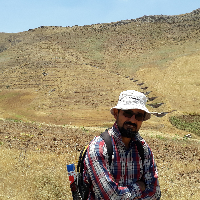Evaluation and quantification of ecosystem services of barley and triticale agroecosystems
Ecosystem services are defined as services provided by the natural environment. These services produce outputs or effects that directly and indirectly impact human well-being, culture, and the global economic system (Feng et al., 2018; Ma et al., 2020). Quantifying the services of agroecosystems is one of the most important strategies to increase attention to these services and provide appropriate solutions to maintain and sustain these services. The development of intensive agriculture has transformed agricultural landscapes into simple, low-coverage single-product systems similar to semi-natural habitats. This change has led to a sharp decline in biodiversity and a reduction in the provision of ecosystem services to agriculture. It has been confirmed that among ecosystem services, pest, and weed control, and pollination have significant impacts on global agricultural production.
In this study, 8 plots were selected from different plots of autumn crops included barley, and triticale. In this study provisioning, supporting, regulating services in the cultivation of barley and triticale fields of Dasht-e Naz, Sari Agricultural Company (Mazandaran province) were evaluated and quantified, during 2019-2020. In this study, some ecosystem services such as insect and weed biodiversity (using Shannon-Weiner, Simpson, Margalf, Uniformity and Menhinick indices), soil microbial respiration, carbon sequestration, organic matter, abundance of earthworms, grain yield, protein content oxygen production, and soil protection (by the stability of aggregates) were evaluated and quantified. Soil samples were taken from a depth of 0-30 cm before barley and triticale planting in November 2019 and after harvest in June 2020 for assessment of rate of microbial respiration, organic matter and carbon sequestration. Also, oxygen production was estimated based on net primary production. A sampling of plant biodiversity and yield of autumn crops was performed based on the W shaped pattern with 0.5×0.5 m2 quadrate. In this study, insects were collected in ways: yellow sticky trap, insect nets, and ground trap. Sampling was done from late March to mid-April 2020. All data were analyzed with SAS version 9.4 and T-test was used to compare the means between cultivars at the 5% probability level.
The results showed that the highest amount of oxygen production was obtained at about 17.66 and 16.57 tons per hectare from 12 and 16 fodder plots for barley and triticale, respectively. In this research, the highest amount of carbon sequestration (2.67 tons per hectare) and the activity of microbial respiration before planting and after harvesting the crop were 91.40 and 45.95 milligrams of CO2 per kilogram of soil per day, respectively andearthworm abundance (13 per square meter) belonged to plot 18. The evaluation of the biodiversity status in insects and weeds showed that the highest Shannon-Weiner diversity index in weeds was 2.65 and 2.89 from plots 12 and 16 of barley and triticale fodder, respectively. Also, in 12 plots of barley and 16 plots of triticale, because the purpose of farming was to produce fodder, herbicides were not used compared to other plots. In another study, it was observed that the highest Shannon-Weiner diversity index was obtained from triticale farms (1.00) and the lowest (0.14) from winter wheat farms(Sawicka et al., 2020). This could increase the Shannon-Weiner index. Also, the Shannon-Weiner index of insect communities was calculated as 2.37 and 2.49 from 19 and 16 plots, for barley and triticale, respectively.4 beneficial insects named Syrphus ribesii, Chrysoperla carnea, Coccinella septempunctata Linnaeus and Apis ellifera mellificawere recorded in the barley and triticale plots studied.
The results of this study showed that crop management and implementation of intensive agricultural systems were effective in providing many ecosystem services of barley and triticale fields. So, these services were affected by various factors, such as cultivar type, crop rotation, and tillage methods. In general, intensive agriculture is associated with climate change and biodiversity loss and alternatively, the reduction of ecosystem services including regulating and provisioning services is inevitable. Therefore, adopting management of agroecosystems associated with natural ecosystems can help to provide more ecosystem services in agroecosystems and maintain their sustainability level.Acknowledgements:We are thankful to Gorgan University of Agricultural Sciences and Natural Resources (GUASNR), the agricultural company of Dasht-e-Naz Sari and Dr. Hamid Sakinin for all his companions and supports.
-
Investigating the Spatial Distribution and Interaction of Sand Dunes: A Case Study of Kalateh Mazinan Region
Mohammadjavad Yousefi, *, Alireza Rashki, Narges Kariminejad, Hamidreza Abbasi, Ali Mohammadian Behbahani
Desert Ecosystem Engineering Journal, -
Presenting Quantitative Approaches to Investigate the Importance of the Stakeholders of Ecosystem Services in Hyrcanian Forests
*, Sareh Hosseini, Sayed Mohsen Hosseini, Maryam Asadpour Kordi, Mahsa Taslimi, Yadollah Bostan
Ecology of Iranian Forests, -
Detection of sinkholes and landslides using deep-learning methods and UAV images
Naeges Kariminejad, Hamid Reza Pourghasemi *, Mohsen Hoseinalizadeh, Vahid Shafaie
Journal of Watershed Engineering and Management, -
Providing a Roadmap for the Adaption of Agricultural Sector to Water Scarcity Conditions (Case Study: Selected Crops of Tajan Basin, Iran)
H. Fouladi, H. Amirnejad *, S. Shirzadi Laskookalayeh
Journal of Economics and Agricultural Development, -
Crop Yield and Growth Trait Response to Varied Nitrogen Fertilization and Pre-Planting of Cover Crops in Rice (Oryza sativa L.)
Hannaneh Mehdipour, *, Samaneh Hasanzadeh, Asieh Siahmarguee
Journal of Agricultural Science and Sustainable Production, -
Changing carbon sequestration potentials based on different land uses; A review
Hossein Kazemi *, Hermann Klug, Samane Bakhshandeh,
Journal of Emergy, Life Cycle and System Analysis in Agriculture, Winter-Spring 2022 -
Evaluation and Quantification of Ecosystem Services in Wheat (Triticum aestivum L.) Agroecosystem
Mostafa Koozehgar, Hossein Kazemi *, , , M. Hosseinalizadeh
Agroecology journal, -
Investigation of plant biodiversity in an agricultural landscape (Case study: Dasht-e- Naz, Sari)
, Hossein Kazemi *, , Hamid Amirnezhad,
Journal of Plant Production,





